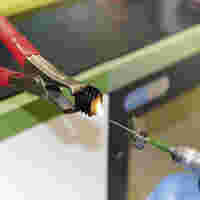
Fire Protection
Trains are the safest mode of transportation. This is ensured not only by the operator, but also by the vehicle and component manufacturers. Whatever the reason for a fire – the passengers must be protected as much as possible.

Trains are the safest mode of transportation. This is ensured not only by the operator, but also by the vehicle and component manufacturers. Whatever the reason for a fire – the passengers must be protected as much as possible.
Fire Protection
Fire Protection per EN 45545
The passengers must be able to escape danger. This is assured by operating characteristics and vehicle construction. Trains are designed and constructed so they can still be driven for a specific time in case of fire, capable of continuing out of a tunnel or across a bridge. Corresponding escape routes must be in place and usable.
Above all, fire must be kept from starting at all costs. If a fire does occur, both flame and the resultant smoke must be kept from spreading. If fumes develop, these must not have any detrimental effects to occupants, nor may smoke density hinder orientation to escape routes.
For these reasons, painstaking attention is given to the use of high-quality materials that meet the above requirements from the earliest stages of conception and development.
So these required material properties could be recognized and compared, the decades-old national European standards (DIN 5510-2, NF F 16-101/-102, BS6853, and others) were harmonized and adopted in European standard EN 45545. EN 45545 took legal force March 2013, and must be applied!

WAGO products meet the requirements of EN 45545-2.
Parts 1 and 2 are relevant for WAGO components.
Part 1 is the generally descriptive section that, among other things, defines and describes the following key data:
Part 2 is the section relevant to materials. The first steps in material selection or consideration include the search for the products listed in Table 2 of EN 45545-2:
Material selection
Step 1: Products Listed in Table 2
Step 2: Products Not Listed in Table 2
Recommended Reading
More Railway System Solutions
Questions about railway suitability refer to compliance with DIN EN 50155. Although EN 50155 does have an international counterpart (IEC 60751), EN 50155 is the current railway standard recognized around the world.


WAGO at Work
Customer Applications: Railway Systems
Kirow railway cranes and slag transporters are always reliable, even under the most inclement weather conditions – with WAGO technology.

The control and error messaging system for the SBB (LSS-CH) replaces 23 different control systems with WAGO's automation technology.
